Grimsby Corporation Tramways
History
Grimsby Corporation became a tramway owner and operator on the 6th of April 1925, when it took over the overhead electric, standard-gauge tramway lines — within the municipal boundary — of the Great Grimsby Street Tramways Company, as well as a proportion of its tramcars.
The corporation acquired 4.39 miles of tramway, comprising a main line running from Welholme Road in the west to the boundary with Cleethorpes in the east — where it met the tracks of the GGSTCo — with a circa one-mile branch line running south through Grimsby. The western terminus was situated outside the People's Park, from where the line initially ran westwards along Welholme Road before turning northwards along Bargate, Deansgate and Victoria Road, then eastwards over the Docks Railway — via a crossing — to Riby Square; from here the main line continued eastwards along Cleethorpes Road to the municipal boundary at Park Street, whilst the branch line ran southwards along Freeman Street and Hainton Avenue to a terminus at the latter's junction with Tasburgh Street.
Although the corporation had had the power to take over the tramway in 1911 as a going concern, it chose not to do so, presumably because it had driven an extremely good bargain with the tramway company over a decade earlier, in exchange for its support for the Great Grimsby Street Tramways Act of 1900. By the early 1920s, however, public feeling had very much swung in favour of municipalisation, the corporation serving notice on the company — on the 18th July 1921 — of its intention to purchase the tramway on the 21st July 1922. Powers were duly obtained on the 4th August 1921 — under the Grimsby Corporation Act, 1921 — to operate the trams, as well as trolleybuses, but not motorbuses, to which the GGTCo and others had successfully objected.
The purchase was, however, far from straightforward, the corporation only having the right to purchase the portion within its municipal area, the rest of the system, i.e., the lines in Cleethorpes (and the depot) remaining with the GGSTCo. The company had envisaged such a scenario in 1911 when the corporation waived its right to buy until 1922, and had, with great foresight, induced Cleethorpes UDC to postpone its right to buy until the 1st August 1930. The company thus had the upper hand in any negotiations on the price, as there was legal precedent for a municipal authority purchasing only a portion of a tramway, where it not only had to pay for the tramway within the municipal boundary, but also damage to the tramway company for having its system severed.
The tramway was in a fairly run-down state following the Great War, a situation that was compounded by the company's reluctance to invest in an asset that could soon be compulsorily purchased by the local authority. The state of the tramway played a major role in the corporation's valuation, so when the company offered to sell the lines (and a proportional share of the tramcar fleet) for £80,000 in 1922, the corporation turned them down flat. Matters inevitably ended up in arbitration, which not only took time and money, but ended with the corporation having to pay £24,000 more than the company had originally been willing to accept, and given that £80,000 was the GGTCo's opening offer, they probably would have settled for much less still had the corporation been willing to negotiate. The decision was binding, so no doubt there was some explaining to do in the council offices, as not only was the price very high, but on top of that, a tramway depot had to be built, a large number of serviceable tramcars had to be obtained, and much track replaced.
The corporation took possession of its share of the tramway on the 6th April 1925, the company temporarily stabling the corporation's trams at Pelham Road depot until such time as the corporation could build and equip its own depot, both parties also agreeing to inter-running between Grimsby and Cleethorpes.
The corporation had meanwhile sourced some replacement tramcars, buying 16 vehicles from Sunderland District Electric Tramways, which was closing, the first of which entered service in May 1925. The branch line along Freeman Street was also a cause for concern, the foundations being inadequate for the marshy ground on which it had been laid; after due consideration, the corporation decided to replace the trams with trolleybuses, the last trams along the branch running on the 2nd October 1926, the trolleybuses taking over the next day.
After having unsuccessfully applied for powers to run motorbuses in 1921, the corporation was more successful in 1927, the first services commencing on the 2nd November 1927. The western extremity of the system — from the Old Market to Peoples Park — which the corporation had forced the GGTCo to operate, despite the latter's contention that it continually made a loss, was now the corporation's problem, and on the 3rd June 1928, the trams were replaced by motorbuses. Motorbus operation was further expanded in 1934 by the purchase of the Provincial Tramways Company's Grimsby motorbus assets (buses and services).
Although the corporation was keen to replace the trams entirely, it was reluctant to purchase more new trolleybuses given the large debt it had incurred in acquiring the tramway. By late 1935, however, the remaining track between Riby Square and Park Street was in such poor condition that further deferment was impossible, so new trolleybuses were ordered. These were placed in service on the 22nd November 1936, interspersed with the trams, the last trams being withdrawn on the 31st March 1937.
Uniforms
Under corporation ownership, motormen and conductors were issued with single-breasted jackets with five buttons — bearing the full system title and municipal shield device (see link) — two breast pockets (with button closures), epaulettes (with button fastenings) and stand-up collars. The epaulettes probably bore an employee number on each side, whereas the collars bore an employee number on the bearer's left-hand side (in individual metal numerals) only, and system initials, 'G C T', on the right-hand side (in individual metal letters). The insignia were probably brass to begin with, but later on nickel (Grimsby Corporation Tramways buttons have survived in brass, nickel and chrome). The tensioned-crown peaked caps bore an untitled municipal-device badge, again probably brass (initially), though eventually superseded by nickel.
Tramcar crews were also provided with double-breasted greatcoats bearing five pairs of buttons, epaulettes, and high fold-over collars; the collars were devoid of insignia, whereas the epaulettes probably bore an employee number.
Inspectors wore typical tramway inspector uniforms, namely: single-breasted jackets with hidden buttons (or more likely a hook and eye affair) with a slit breast pocket, and both pocket and jacket edged in a finer material than the main body; the stand-up collars probably bore the grade — 'Inspector' — in embroidered script lettering. The tensioned-crown peaked caps probably bore the grade, again in embroidered script lettering, but on a hat band.
Further reading
For a history of Grimsby Corporation Tramways, see: 'The Tramways of Grimsby, Immingham and Cleethorpes' by J H Price; Light Rail Transit Association (1991).
Images
Motormen and conductors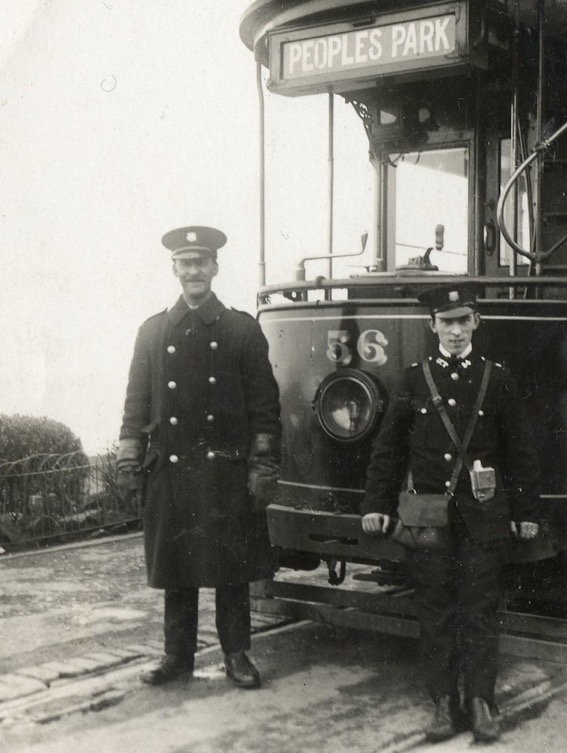
The crew of Tram No 56 pose for the camera at Kingsway in Cleethorpes — photo undated, but given the smart condition of the tram, probably taken not long after 1925 when this vehicle was acquired from Sunderland District Electric Tramways. Author's Collection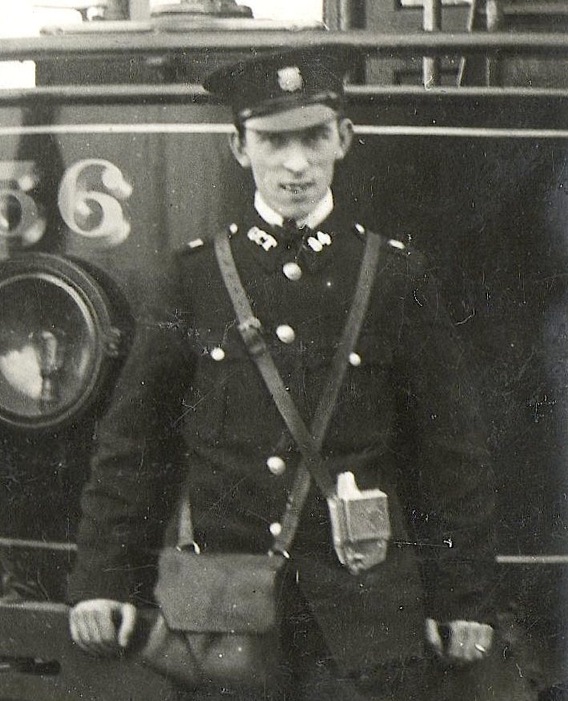
An enlargement of the above photograph showing details of the conductor's uniform. The collars bear an employee number on the left-hand side (this appears to be '84') and system initials ('G C T') on the right-hand side. The epaulettes also appear to carry an employee number.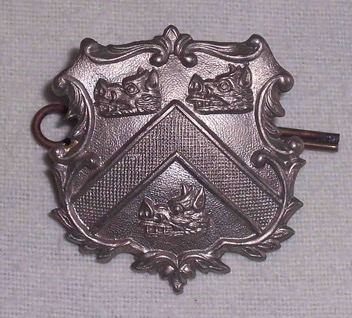
A Grimsby municipal-device badge, as worn on Grimsby Corporation Tramways uniform caps — nickel. These badges were probably brass initially, though a change was undoubtedly made to nickel and perhaps even to chrome, titled 'Grimsby Corporation Tramways' buttons having survived in all three materials. Author's Collection.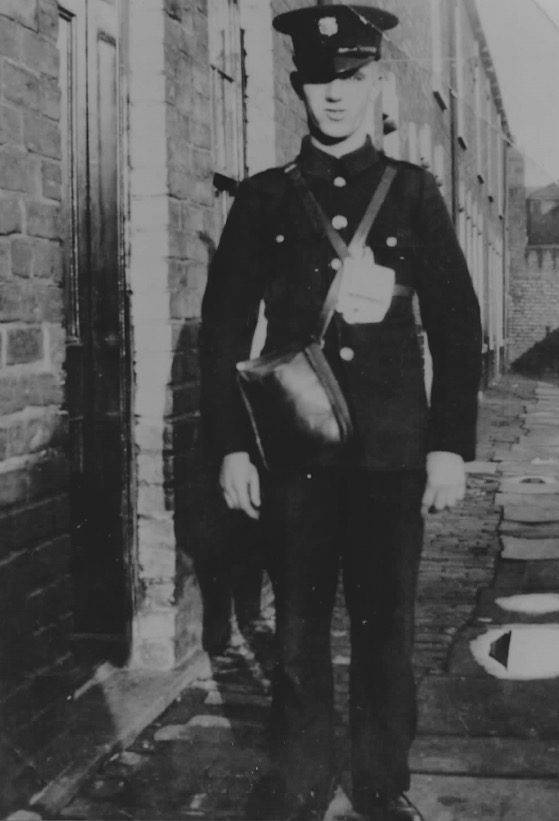
A Grimsby Corporation conductor — photo undated, but probably taken in the late 1920s or the early 1930s. It is not clear whether he was a tram, bus or trolleybus conductor, though no doubt the uniforms were the same. Unlike the previous photograph, his collars are unadorned. Photo courtesy of the Jill Smith Collection.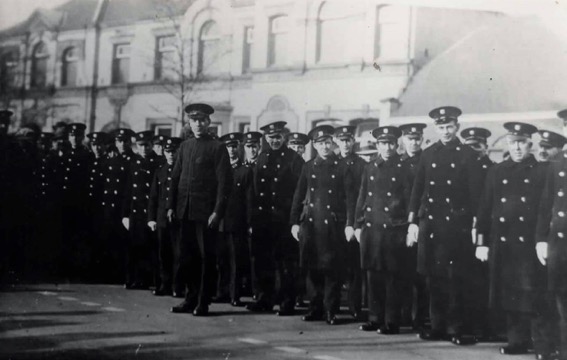
A line up of GCT staff outside the Town Hall during an unknown formal occasion, possibly a funeral — photo undated, but probably taken in the 1930s. Photo courtesy of the Jill Smith Collection.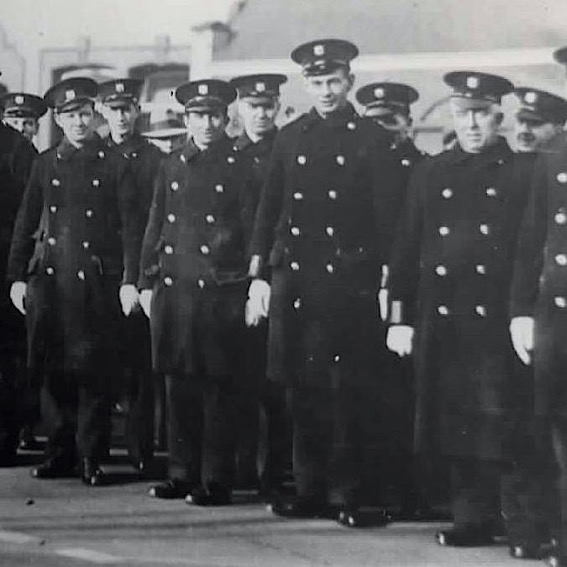
An enlargement of the above photograph showing some of the motormen and the conductors in their greatcoats; all the collars on show are plain, i.e., devoid of badges of any kind.
Senior staff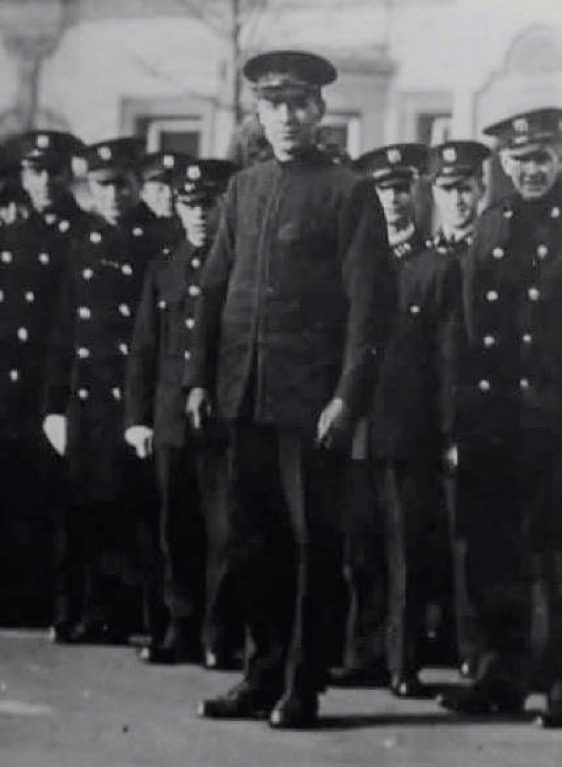
An enlargement of the parade photograph above showing the inspector, who is wearing typical tramway inspector garb.